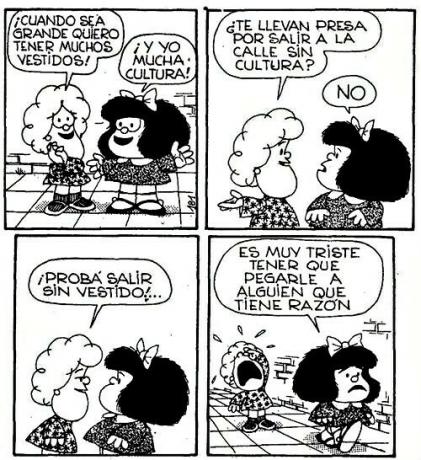The words very and a lot often cause some doubts regarding use.
So much very how much a lot has the same meaning: much.
Examples:
- I want you so much. (I like much from you.)
- The school is muy lejos de here. (the school is much far away.)
Although they have the same meaning, the usage, however, is different.
Use of very
very is an adverb of intensity used before adjectives, adverbs and adverbial phrases.
Examples:
- maria is very tired. (Maria is very tired.)
- Pablo salió very quickly. (Pablo left very quickly.)
- Juan habla english muy bien. (Juan speaks English very well.)
Use of a lot
Mucho is a determinative quantifier adjective used before nouns and after verbs.
Examples:
- Julio works a lot. (Julio works a lot.)
- ayer llovió mucho. (It rained a lot yesterday.)
- It has grown a lot since I last saw you! (You've grown a lot since the last time I saw you!)
IMPORTANT
When a lot comes before nouns, it agrees in gender and number with the noun it precedes.
Examples:
- Hay muchas playas in Brazil. (There are many beaches in Brazil.)
- I have many friends. (I have many friends.)
- Many people do not believe in this group. (Many people didn't believe in this group.)
- Many tourists come to El Verano. (Many tourists come for the summer.)
- I don't have high expectations. (I don't have high expectations.)
Exceptions
Although the usage rule indicates that we must use the very before adjectives and adverbs, there are exceptions.
if the adverb is before, after, major, smaller, better or worse, we must use a lot and not very.
Examples:
- The teachers got to know much before the children. (Teachers arrived long before the children.)
- We talk a lot after medianoche. (We arrived long after midnight.)
- The film is much better than that. (The movie is much better than you think.)
- Mi hermano is much smaller than yo. (My brother is much younger than me.)
- The offer is much greater than the demand. (The supply is much greater than the demand.)
- It could have been much worse. (It could have been a lot worse.)
difference between much and much
Like a lot and very have the same meaning (much), the difference between the use of each is established by the grammatical function of the words that surround them.
I.e:
- Mucho: used before nouns, after verbs and before the following adverbs: before, after, smaller, major, better and worse.
- very: used before adjectives, adverbs and adverbial phrases.
Video
Check the video below for a summary of the use of very and a lot and also about exceptions.
Exercises
1. (UECE/2015)
Signal the correct employment of la forma mucho (complete) or of la forma muy (recovered).
a) Mucho salad estaba la carne.
b) There was a lot after the mediation.
c) I like very hot coffee.
d) We have to work muy en serio.
Correct alternative: d) We have to work muy en serio.
In letter d) the word "muy" was used correctly as it appears before an adverbial phrase ("en serio").
See why the other alternatives are wrong:
a) In alternative a), the word "mucho" should have been used in the feminine form to agree with the word "salad".
b) Although the word "después" is an adverb and we use "muy" before adverbs, adverbial phrases and adjectives, it is one of the words in the list of exceptions.
Before the adverbs "before", después, "mejor", "peor", "minor" and "mayor", we must use "mucho" and not "muy".
c) In alternative c), the use of "mucho" is wrong because the word "caliente" is an adjective. Before adjectives we should use "muy" and not "mucho".
2. (UECE/2018)
The apocopada form MUY correctly completes the sentence
a) Ella always repeat that she wants me to ___________.
b) The temperature is mild, in the ___________ heat.
c) I tell you ___________ in serious.
d) Then it will be ___________ better.
Correct alternative: c) I tell you ___________ en serio.
In sentence c) the word "muy" was used correctly, because then there is an adverbial phrase ("en serio"). The word "muy" is used before adverbial phrases, adverbs and adjectives.
In all other remaining alternatives, only the word "much" can be used. The word "mucho" is used before nouns, after verbs and before the adverbs "before", "después", "minor", "mayor", "mejor" and "peor".
3) (UECE/2005)
The word “muy” (“… no están muy behind”) is CORRECTLY used in the option:
a) The hambre in Africa is muy mayor that in Brazil.
b) Hambre indexes in the world are increasing very rapidly.
c) There is much more present in underdeveloped countries.
d) Only after that it was realized that the goals had been achieved.
Correct alternative: b) Hambre in the world tends to increase very quickly.
The word "muy" was used correctly as it is followed by an adverb ("quickly"). The word "muy" is used before adverbial phrases, adverbs and adjectives.
In all other alternatives, the word "mucho" should have been used instead of "muy". "Mucho" is used before nouns, after verbs and before the adverbs "before", "después", "minor", "mayor", "mejor" and "peor".
4) (UFSM-RS)
__Hay something that the email will never be able to replace in the epistolary relationship.
__ It's a lot faster, no matter the spelling.
__ I like the gum de las estampillas.
El Clarín, May 22, 2001.
If the referent of the phrase "Es mucho más quickly" were "letters" and the same verb tense was maintained, the correct wording would be as follows:
a) I'm too fast
b) Sound much faster
c) Son muy mais fast
d) Son very much faster
e) It will be much faster
Correct alternative: b) Son much more fast
Alternative b) is correct because the verb "son" and the adverb "rapida" agree with the word "cards", being used in the plural and feminine plural respectively.
See why the other alternatives are wrong:
a) Taking into account the word "letters", there is an error in agreement in alternative a) since the verb used is in the singular ("es").
c) In alternative c), what sets an error is the use of "muy" after the verb "son". Following the use of a verb, the word to be used to indicate intensity is "much" and not "muy".
d) Alternative d) is grammatically correct, however, it alters the meaning of the original sentence, adding an even greater degree of intensity through the use of the superlative "muchísimo".
e) Although alternative e) is correct, it does not use the same verb tense as the original sentence. The original phrase is in the present ("es") and the alternative e) in the future ("serán").



